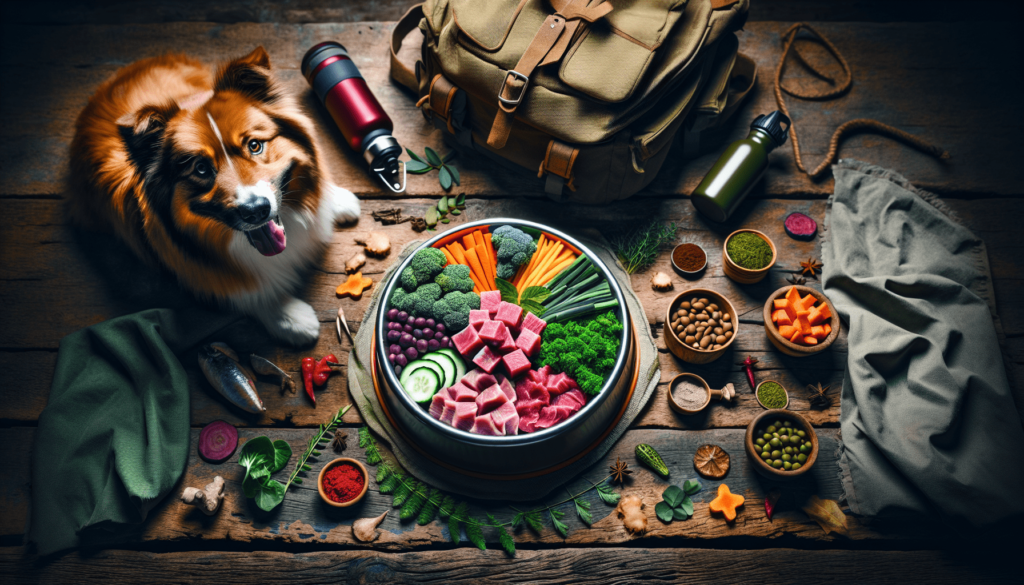Have you ever considered how the food you give your dog might influence their strength, health, and adventurous spirit?
The concept of raw feeding is gaining popularity among dedicated pet owners who want to provide their canine companions with a diet that mimics what their wild ancestors would have eaten.
This article will guide you through the benefits of raw feeding, particularly for those who seek to explore the great outdoors with their four-legged friends.
What Is Raw Feeding?
Raw feeding is a dietary approach that involves providing your dog with uncooked meat, bones, fruits, and vegetables.
Many pet owners believe this diet leads to improved health and vitality.
The idea is simple: feed your dog as they would have eaten in the wild, which is thought to provide numerous advantages.
How Does Raw Feeding Differ From Commercial Dog Food?
When you choose to raw feed, you skip over processed dog foods which often contain fillers and artificial additives.
Instead, you focus on whole food choices that offer a range of nutrients in their natural state.
This shift can lead to a myriad of health benefits for your dog, setting the foundation for better digestion, a shinier coat, and increased energy levels.
Why Are More Owners Turning to Raw Feeding?
As pet owners become more aware of the ingredients in commercially available dog food, many are seeking healthier alternatives.
Raw feeding allows you to take control of your dog’s diet, tailoring it to their specific needs, preferences, and activity levels.
Strengthening Your Dog Through Nutrition
Feeding your dog a raw diet can significantly affect their physical strength and overall health.
Many dog owners who have made the transition to raw feeding report noticeable changes in their pets’ vitality and energy.
What Nutrients Do Raw Foods Provide?
Raw foods are packed with essential nutrients such as proteins, fats, vitamins, and minerals.
These nutrients play vital roles in maintaining muscle health, supporting the immune system, and promoting healthy skin and fur.
How Does Raw Feeding Aid Digestion?
Many dogs experience digestive upsets with commercial foods filled with grains and fillers.
Raw diets, being easier on the digestive system, promote healthier gut flora and can alleviate issues like diarrhea and bloating.
Can Raw Feeding Improve Energy Levels?
Owners frequently notice an increase in their dog’s energy after switching to raw feeding.
Healthy foods provide the right fuel needed for an active lifestyle, which is particularly important if you and your dog are adventurers at heart.
Does Raw Feeding Reduce Allergies?
Many allergy issues stem from the ingredients found in processed foods, including grains and artificial additives.
By feeding raw, you control your dog’s diet, which can help identify and eliminate allergens, leading to fewer skin irritations and discomfort.

Practical Aspects of Implementing a Raw Diet
Switching to a raw feeding regimen may feel overwhelming at first, but breaking it down into manageable steps can make it more accessible.
What Should You Include in a Raw Diet?
A nutritionally balanced raw diet typically includes muscle meat, organs, bones, fruits, and vegetables.
Each component plays an essential role in ensuring your dog receives the necessary nutrients.
How Do You Ensure a Balanced Diet?
It is crucial to ensure that you’re providing a balanced diet that meets the nutritional needs of your dog.
Most experts suggest a ratio of roughly 70% meat, 10% bone, and 20% fruits and vegetables for a well-rounded raw diet.
How Can You Transition Your Dog to a Raw Diet Smoothly?
When transitioning to a raw diet, consider doing so gradually.
Start by introducing raw meat while simultaneously decreasing the amount of commercial food.
This gradual approach can help your dog adjust without causing digestive issues.
Where Can You Source Raw Ingredients Safely?
Finding a reliable source for raw ingredients is pivotal for your dog’s health.
Many pet stores now offer pre-packaged raw diets, and local farmers or butcher shops can be excellent resources for fresh ingredients.
Addressing Common Concerns About Raw Feeding
While raw feeding comes with numerous benefits, it’s essential to discuss common concerns pet owners may have before making the change.
Is Raw Feeding Safe for All Dogs?
In general, many healthy dogs do well on raw diets; however, it might not be suitable for every dog, particularly those with certain health conditions.
Consulting with your veterinarian before making this dietary shift is wise.
How Do You Manage Food Safety with Raw Feeding?
Food safety is a valid concern, as raw meat can carry pathogens harmful to pets and humans.
Implement best practices, such as proper storage, handling, and sanitation, to minimize such risks.
Are There Risks Involved with Raw Bones?
Feeding bones can, at times, pose risks, especially if they are cooked or small enough for your dog to swallow whole.
Opt for large, raw bones to promote dental health while ensuring safety.
How Do You Know if Your Dog is Adjusting Well?
Monitoring your dog’s energy, coat condition, stool consistency, and overall health can indicate whether they are adjusting well to raw feeding.
Look for positive changes as signs that the diet is beneficial.
Enhancing Your Outdoor Adventures with a Raw-Fed Dog
If you love taking your dog outdoors, raw feeding can complement that adventurous lifestyle.
How Can a Raw Diet Support Your Dog’s Activity Levels?
A diet rich in nutrients can enhance stamina, optimize muscle recovery, and improve overall performance in physically demanding activities, be it hiking, running, or any outdoor adventures.
What Should You Pack for Your Outdoor Excursions?
Planning outdoor activities means you need to think about your dog’s dietary requirements.
Consider portion sizes and storage solutions when preparing raw food to ensure your dog remains nourished during adventures.
How Does Raw Feeding Affect Your Dog’s Hydration Needs?
Raw feeding may impact your dog’s hydration levels since raw meat typically comprises a higher moisture content compared to kibble.
Keep fresh water accessible during outdoor excursions for optimal hydration.
Can You Use Raw Feeding to Train for Outdoor Sports?
Many owners report that their dogs show improved focus and energy when trained on a raw diet, making it an excellent option for those interested in engaging their dogs in competitive outdoor sports.
Real-Life Success Stories of Raw Feeding
Hearing from those who have made the transition can often alleviate concerns and inspire confidence.
How Have Other Owners Benefited from Raw Feeding?
Many dog owners tell stories of how their pets seemed more vibrant, playful, and happier after switching to raw feeding.
These anecdotes often serve as encouragement for those contemplating the change.
Can You Share Examples of Dogs Who Thrived on a Raw Diet?
Imagining your dog thriving on raw food can be a motivating factor.
Countless testimonials illustrate dogs overcoming allergies, achieving healthier weights, and attaining a new level of playfulness with a raw diet.
What Challenges Did Others Face When Switching to Raw Feeding?
It’s essential to acknowledge that every change has its hurdles.
Some pet owners have encountered challenges, such as initial reluctance from their dogs or the need for more research and planning.
How Did Owners Overcome These Challenges?
By staying patient and committed to learning, many owners successfully navigated the challenges of switching to raw feeding and ultimately experienced the rewards it brought to their dogs’ lives.
Frequently Asked Questions About Raw Feeding
- Is raw feeding suitable for puppies?
- Yes, raw feeding can benefit puppies, but it’s crucial to ensure they receive the right nutrients for growth.
- How much raw food should I give my dog?
- A common guideline is to provide about 2-3% of your dog’s body weight in raw food each day, adjusted according to activity level and health.
- Can I mix raw with commercial kibble?
- It’s generally advised against mixing raw and kibble as they digest differently, potentially leading to digestive upset.
- What are the signs of a poorly balanced raw diet?
- Look for issues like poor coat condition, lack of energy, and irregular stools, which can signal nutritional deficiencies.
- How can I ensure my raw diet is complete and balanced?
- Consulting with a veterinarian or a pet nutritionist can help create a balanced raw feeding plan tailored to your dog.
- What raw fruits and vegetables are safe for dogs?
- Safe options include carrots, blueberries, and apples (without seeds), among others. It’s essential to research before introducing new foods.
- How can I reduce the risk of bacterial infections with raw feeding?
- Adopt strict food handling practices, such as washing your hands, sanitizing surfaces, and keeping food at safe temperatures.
- Can older dogs switch to a raw diet?
- Many older dogs can thrive on raw diets, especially if they have specific health concerns addressed through appropriate food choices.
- Is it more expensive to feed raw?
- While initial costs may be higher, some owners find that creating their own raw diets can ultimately save money compared to premium commercial brands.
- Can I prepare raw food at home?
- Absolutely! Many owners choose to prepare raw meals at home, ensuring quality ingredients and portion control tailored to their dog’s needs.
Conclusion
Transitioning to a raw feeding regimen can be a transformative journey, benefiting both you and your dog.
By understanding the components involved and addressing any concerns, you can create a diet rich in nutrients that supports your dog’s health and adventurous lifestyle.
As you embark on this journey, remember to take your time, observe your dog’s preferences, and seek out resources to assist you along the way.
Now that you’ve explored the benefits of raw feeding, consider taking the next step!
Research recipes, consult with professionals, and embark on this exciting path to a healthier, happier life for your dog.
